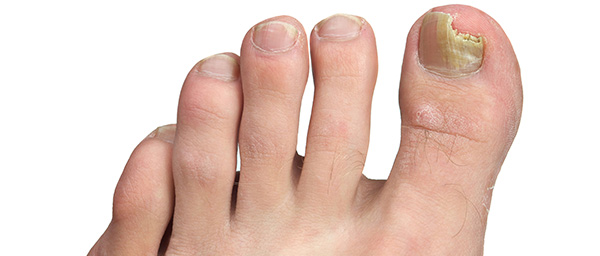Fungal infection of the nail, onychomycosis, is often ignored because the infection can be present for years without causing any pain. The disease is characterized by a progressive change in a toenail’s quality and colour.
In reality, the condition is an infection underneath the surface of the nail caused by fungi. When the tiny organisms take hold, the nail often becomes darker in colour and foul smelling. Debris may collect beneath the nail plate. White marks frequently appear on the nail plate and the infection is capable of spreading to other toenails. As a result of the fungus, the nails could become thickened and are difficult to trim and walking could be painful when wearing shoes. Onychomycosis occasionally can also be accompanied by a secondary bacterial or yeast infection in or about the nail plate.

Fungus is the most common cause of nail infection.
It is difficult to avoid contact with microscopic organisms like fungi since they are ubiquitous in our environment. Toenails are especially vulnerable around damp areas where people are likely to be walking barefoot, such as swimming pools, locker rooms, and showers. Injury to the nail bed may make it more susceptible to all types of infection, including fungal infection. Those who suffer from chronic diseases such as diabetes, circulatory problems, or immune-deficiency conditions, are especially prone to fungal nails. Other contributing factors may be a history of athlete’s foot and excessive perspiration.
Prevention
- Proper hygiene and regular inspection of the feet and toes are the first lines of defence against fungal nails
- Clean and dry feet resist disease
- Washing the feet with soap and water, remembering to dry thoroughly
- Shower shoes should be worn when possible in public areas
- Shoes, socks, or hosiery should be changed more than once daily
- Toenails should be clipped straight across so that the nail does not extend beyond the tip of the toe
- Wear shoes that fit well and are made of materials that breathe
- Avoid wearing excessively tight hosiery which promote moisture
- Socks made of synthetic fibre tend to “wick” away moisture faster than cotton or wool socks
- Disinfect instruments used to cut nails
- Disinfect home pedicure tools
- Don’t apply polish o nails suspected of infection
Treatment
Fungal nail infections may be difficult to treat and may become a reservoir for fungal organisms, causing them to return in the skin or nails. The fungal nail infection is cured by the growth of new, non-infected nails. Even with successful treatment, a relapse is common. There are a variety of treatments available from over the counter topical medication, herbal remedies, prescription topical or oral medications, procedures, or laser treatments. Over the counter medications generally are not very effective and have high rate of recurrence. The type of treatment chosen depends on the severity of the condition and any co-existing medical factors. For best results, a foot doctor can detect a fungal infection early, culture the nail, determine the cause, and form a suitable treatment plan. Occasionally, temporary removal of the infected nail can be performed to permit direct application of a topical anti-fungal. Permanent removal of a chronically painful nail that has not responded to any other treatment permits the fungal infection to be cured and prevents the return of a deformed nail.

